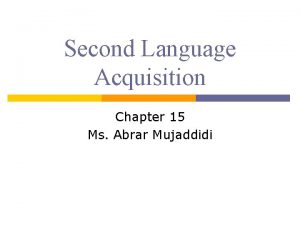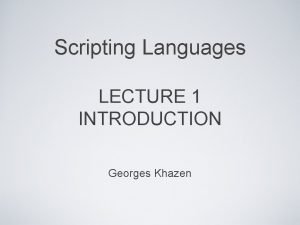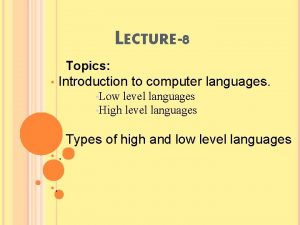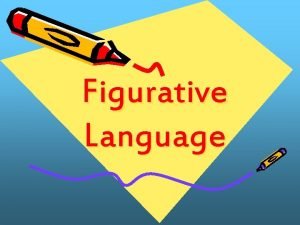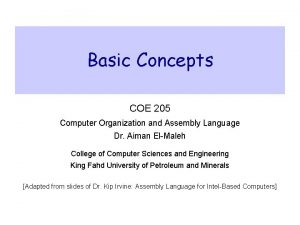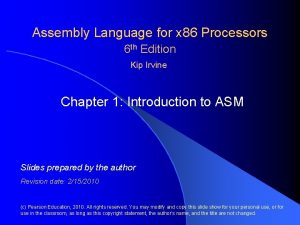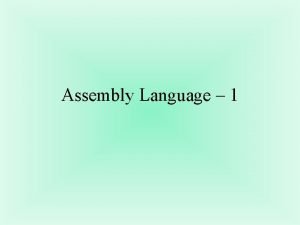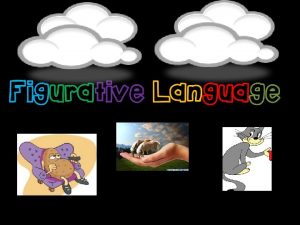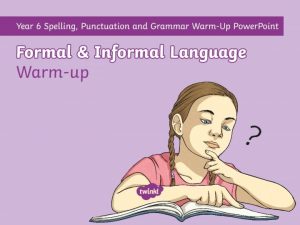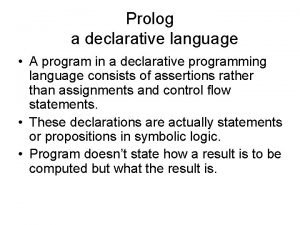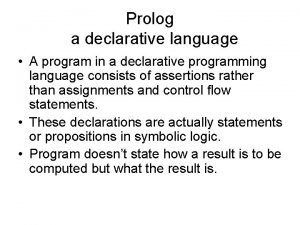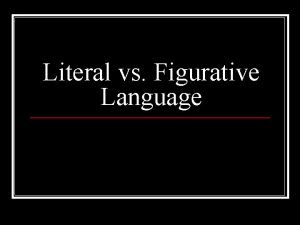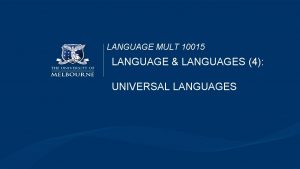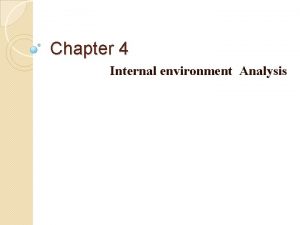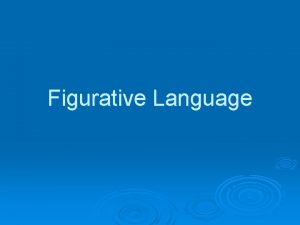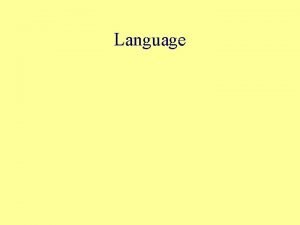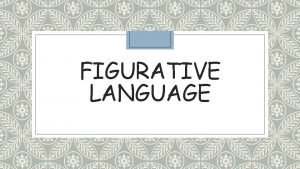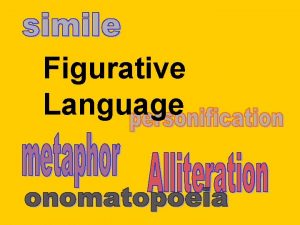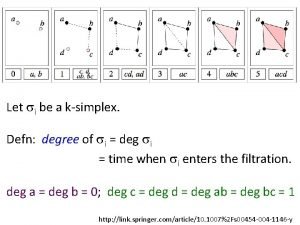Chapter 2 Languages Languages n Defn A language















- Slides: 15

Chapter 2 Languages

Languages n Defn. A language is a set of strings over an alphabet. Ø n A more restricted definition requires some forms of restrictions on the strings, i. e. , strings that satisfy certain properties Defn. The syntax of a language restricts the set of strings that satisfy certain properties. 2

Languages n Defn. A string over an alphabet X, denoted , is a finite sequence of elements from X, which are indivisible objects • Ø e. g. , Strings can be words in English The set of strings over an alphabet is defined recursively (as given below) 3

Languages n Defn. 2. 1. 1. Let be an alphabet. *, the set of strings over , is defined recursively as follows: (i) Basis: *, the null string (ii) Recursion: w *, a wa * (iii) Closure: w * is obtained by step (i) and a finite # of step (ii) Ø n The length of a string w is denoted length(w) Q: If contains n elements, how many possible strings over are of length k ( *)? 4

Languages n n n Example: Given = {a, b}, * includes , a, b, aa, ab, ba, bb, aaa, … Defn 2. 1. 2. A language over an alphabet is a subset of *. Defn 2. 1. 3. Concatenation, is the fundamental binary operation in the generation of strings, which is associative, but not commutative, is defined as i. ii. Basis: If length(v) = 0, then v = and uv = u Recursion: Let v be a string with length(v) = n (> 0). Then v = wa, for string w with length n-1 and a , and uv = (uw)a 5

Languages n n n Example: Let = ab, = cd, and = e Ø ( ) = ( ) , but Ø , unless = , or = . Exponents are used to abbreviate the concatenation of a string with itself, denoted un (n 0) Defn 2. 1. 5. Reversal, which is a unary operation, rewrites a string backward, is defined as i) Basis: If length(u) = 0, then u = and R = . ii) Recursion: If length(u) = n (> 0), then u = wa for some string w with length n - 1 and some a , and u. R = aw. R n Theorem 2. 1. 6. let u, v *. Then, (uv)R = v. Ru. R. 6

Languages n Finite language specification Ø Example 2. 2. 1. The language L of string over {a, b} in which each string begins with an ‘a’ and has even length. i) Basis: aa, ab L. ii) Recursion: If u L, then uaa, uab, uba, ubb L. iii) Closure: u L only if u is obtained from the basis elements by a finite number of applications of the recursive step. n Use set operations to construct complex sets of strings. Ø Defn 2. 2. 1. The concatenation of languages X and Y, denoted XY, is the language XY = { uv | u X and v Y } Ø Given a set X, X* denotes the set of strings that can be defined with and 7

Languages n Defn 2. 2. 2. let X be a set. Then X* = U X i i=0 Ø n and X+ = U X i i=1 X+ = XX* or X+ = X* - { } Observation: Formal (i) recursive definitions, (ii) concatenation, and (iii) set operations precisely define languages, which require the unambiguous specification of the strings that belong to the language. 8

Regular Sets and Expressions n Defn 2. 3. 1 Let be an alphabet. The regular sets over are defined recursively as follows: (i) Basis: , { }, and { a }, a , are regular sets over . (ii) Recursion: Let X and Y be regular sets over . The sets X Y, XY and X* are regular sets over . (iii) Closure: Any regular set over is obtained from (i) and by a finite number of applications of (ii). n Example: Describe the content of each of the following regular sets: (i) { aa }*, (ii) { a }* { b }*, (iii) ({a} {b})*, (iv) { a } ({b}{c})* Ø Regular expressions are used to abbreviate the descriptions of regular sets, e. g. , replacing { b } by b, union ( ) by (, ), etc. 9

Languages Examples. n (a) The set of strings over { a, b } that contains the substrings aa or bb L = {{a} {b}}*{a}{a}{{a} {b}}* {{a} {b}}*{b}{b}{{a} {b}}* n (b) The set of string over { a, b } that do not contain the substrings aa and bb L = (a, b)* - ((a, b)*aa(a, b)* (a, b)*bb(a, b)*) [non-regular set] n (c) The set of strings over {a, b} that contain exactly two b’s L = {a}*{b}{a}* 10

Regular Sets and Expressions n Defn 2. 3. 2. let be an alphabet. The regular expressions over are defined recursively as follows: (i) Basis: , , and a, a , are regular expressions over . (ii) Recursion: Let u and v be regular expressions over . Then (u, v), (uv) and (u)* are regular expressions over . (iii) Closure: Any regular expression over is obtained form (i) and by a finite number of applications of (ii). Ø It is assumed that the following precedence is assigned to the operators to reduce the number of parentheses: *, , 11

Regular Sets and Expressions n Example: Give a regular expression for each of the following over the alphabet { 0, 1 }: Ø { w | w begins with a ‘ 1’ and ends with a ‘ 0’ } Ø { w | w contains at least three 1’s} Ø { w | w is any string without the substring ‘ 11’ } Ø Ø n { w | w is a string that begin with a ‘ 1’ and contain exactly two 0’s } { w | w contains an even number of 0’s, or contains exactly two 1’s and nothing else } Regular expression definition of a language is not unique. 12

Regular Expression Identities TABLE 2. 1 Regular Expression Identities 1. u = 2. u = u 3. * = 4. * = 5. u v=v u 6 u =u 7. u u=u 8. u* = (u*)* 9. u (v w) = uv uw 10. (u v) w = uw vw 11. (uv)*u = u (vu)* 12. (u v)* = (u* v)* = u* (u v)* = (u vu*)* = (u*v*)* = u* (vu*)* = (u*v)* u* 13

Regular Expressions n n There exist non-regular expressions such as Ø {anbn | n 0} Ø {(0, 1)*(01)n(0, 1)*(10)n(0, 1)*1 | n 0} Table 2. 1 Regular Expression Identities Ø Ø n * = ; The * operation puts together any number of strings from the language to get a (new) string in the result. If the language is empty, the * operation can put together 0 strings, giving only the null string ( ). u = u = ; Concatenating to any set yields . (a, )(b, ) = { , a, b, ab}. Ø How about c*(b, ac*)*? The regular expression c*(b, ac*)* yields all strings that do not contain the substring bc. 14

Grammars Languages and Accepting Machines Grammars Languages Accepting Machines Type 0 grammars, Phrase-structure grammars, Unrestricted grammars Recursively enumerable Unrestricted Type 1 grammars, Context-sensitive grammars, Monotonic grammars Contest-sensitive languages Type 2 grammars, Context-free grammars Context-free languages PDA Type 3 grammars, Regular grammars, Left-linear grammars, Right-linear grammars Regular languages FSA NDFA TM NDTM Linear-bounded Automata 15
 Acquisition vs learning
Acquisition vs learning Difference between second language and foreign language
Difference between second language and foreign language Interpreted language vs compiled language
Interpreted language vs compiled language Standard language in sociolinguistics
Standard language in sociolinguistics Low-level programming language
Low-level programming language Hardware description language (hdl) can be used as a
Hardware description language (hdl) can be used as a Grant always turns in his homework
Grant always turns in his homework Assembly language vs high level language
Assembly language vs high level language Difference between assembly language and machine language
Difference between assembly language and machine language Difference between assembly language and machine language
Difference between assembly language and machine language Figurative language is language that
Figurative language is language that Formal language and informal language
Formal language and informal language Scienze della formazione
Scienze della formazione Prolog declarative
Prolog declarative Prolog declarative
Prolog declarative Figurative vs literal
Figurative vs literal

